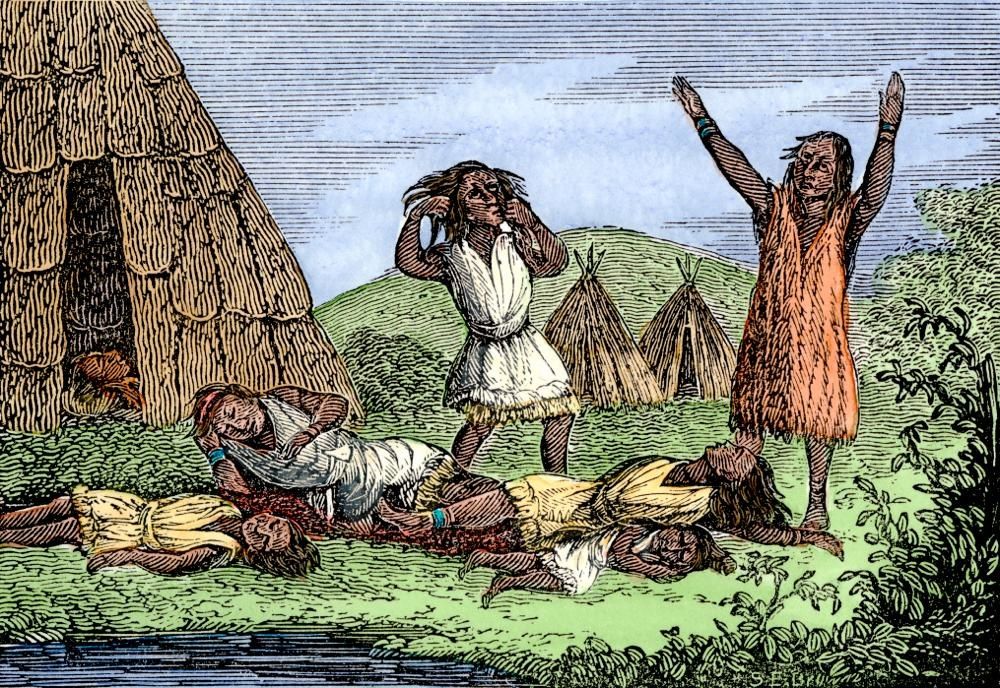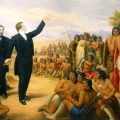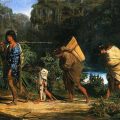
The European conquest of North America was made possible by the epidemic diseases the first explorers, missionaries and traders brought with them. During the sixteenth century the Indian death toll from European diseases was in the millions.
There were an estimated 18 million Native Americans living north of Mexico at the beginning of the sixteenth century. With regard to the health of this native population, sociologist Russell Thornton, in his book American Indian Holocaust and Survival: A Population History Since 1492, reports:
“There are overwhelming indications that the peoples of North America and the entire Western Hemisphere were remarkably free of serious diseases before the Europeans and Africans arrived.”
In his book Their Numbers Become Thinned: Native American Population Dynamics in Eastern North America, Henry Dobyns puts it this way:
“The near-absence of lethal pathogens in the aboriginal New World allowed the native people to live in almost a paradise of well-being that contrasted with their historic purgatory of disease. People simply did not very often die from illnesses prior to the Columbian Exchange.”
A number of reasons have been suggested for this good health. Some scientists have suggested that Indian people came to this continent through the cold, harsh climate of the north and that this acted as a germ filter which screened out infectious diseases. Others have suggested that Indians were disease-free because of the lack of domesticated animals. Measles, smallpox, and influenza are among the diseases which are closely associated with domesticated animals. Russell Thornton writes:
“there were comparatively few opportunities in this hemisphere for horizontal transfer of infections from animal reservoirs of disease to human beings.”
Another aspect of the good health of American Indians was relative lack of starvation and hunger. Unlike the Europeans, Indian political leaders did not store their wealth but rather they accumulated prestige by giving gifts to those in need. Historian Alan Taylor, in his book The Divided Ground: Indians, Settlers, and the Northern Borderland of the American Revolution, writes:
“No one starved in an Iroquois village unless all did so.”
With the European arrival to this continent came epidemics unlike anything Native Americans had experienced. Henry Dobyns writes:
“Colonists brought with them Old World pathogens that escaped from their original hosts to invade new territory. Because the native population lacked immunity to viruses and germs that evolved in the Old World, Indians succumbed in large numbers to ailments that scarcely afflicted the immune colonists.”
Henry Dobyns also reports:
“When the first smallpox pandemic struck the New World peoples in 1520, Native Americans lacked any cultural pattern for dealing with contagious disease that had evolved in the Old World. They lacked any cultural behavior identifiable as nursing.”
One of the primary ways of dealing with disease among most of the tribes was the sweat bath which actually increased Indian mortality from febrile diseases such as smallpox, measles, and chickenpox.
The diseases brought to this continent by the Europeans included bubonic plague, chicken pox, pneumonic plague, cholera, diphtheria, influenza, measles, scarlet fever, smallpox, typhus, tuberculosis, and whooping cough. There are many who would add alcoholism to this list. The impact of these diseases over the next few centuries would be devastating. In his work on the Columbia Exchange (The Columbian Exchange: Biological and Cultural Consequences of 1492), Alfred Crosby writes:
“The fatal diseases of the old world killed more effectively in the New, and the comparatively benign diseases of the Old World turned killer in the New.”
Russell Thornton writes:
“Without a doubt, the single most important factor in American Indian population decline was an increased death rate due to diseases introduced from the Eastern Hemisphere.”
The most lethal European pathogen, in terms of total number of deaths, was smallpox. The second largest killer of Native Americans was measles. Smallpox first struck American Indians in what is now the United States by 1520 and measles by 1531. Bubonic plague and influenza are tied for third in terms of total deaths. Both of these reached the Americas after smallpox and measles and so that population had already been reduced.
It was not uncommon for Native people to encounter the deadly European diseases long before they encountered European people. For thousands of years, Native American trade routes interconnected the many diverse cultures on this continent. The new European diseases simply followed these trade routes, being carried by both the traders and their goods. In their work on the Hopi (A Hopi Social History: Anthropological Perspectives on Sociocultural Persistence and Change), Scott Rushforth and Steadman Upham state:
“epidemic smallpox spread to native southwestern populations before direct contact with the Spanish.”
It was not uncommon for epidemics to kill 30% to 70% of the tribes infected. This was a fatality rate, by the way, which is comparable with European villages infected with the same diseases.
Writing about the Algonquian-speaking groups in North Carolina in the Handbook of North American Indians, Christian Feest reports:
“During the presence of the early English colonists in coastal North Carolina, measles, smallpox, and colds must have pushed the death rate to 25 percent or more in some villages.”
The European diseases devastated many nations and consequently European explorers, particularly in the southeast and northeast, frequently reported finding empty villages and fields. From these reports came the common misconception that North America was only sparsely populated by Indians.
Writing about the Creek (Muskogee) in the Southeast (Georgia and Alabama), historian Mary Jane Warde, in her book George Washington Grayson and the Creek Nation, 1843-1920, reports:
“A Muskogee population extrapolated at two hundred thousand before the Europeans arrived on the continent had declined to about twenty thousand by the time Europeans actually visited their villages.”
Briefly described below are a few of the known epidemics that occurred in the sixteenth century. Many of the epidemics that impacted Indian nations in the sixteenth century were not recorded by the European writers of the time.
In 1520, smallpox struck several Southwestern Indian tribes.
By 1521, disease had reduced the population of the Timucua in Florida to 361,000 from a high of 772,000 prior to European contact.
In 1528, an epidemic of measles or typhoid fever struck some Florida Indian groups with a mortality rate of about 50%. Henry Dobyns estimates that 180,500 Timucua died.
In 1528, the Karankawa in Texas were struck with cholera and half of one band dies.
The tribes of the Southern Plains suffered a measles epidemic in 1531.
In 1545, bubonic plague swept through a number of Florida Indian tribes with a mortality rate of about 12.5%. Henry Dobyns (1983: 293) estimates that 22,500 Timucua die.
Bubonic plague swept through the southwest in 1545, following the Spanish explorer Coronado’s footsteps.
In Florida, mumps were introduced to the Native American populations in 1540 by Indian canoe traders who traveled to the Caribbean islands.
In 1559, a major influenza pandemic struck the native people of Florida. It was carried by the Spanish colonists at Pensacola. This colonial expedition included several Florida Indians who were being returned to their homes. Henry Dobyns reports:
“The Native Americans from Florida who returned there with the de Luna expedition provided an ideal mechanism for spreading influenza widely among Native Americans as they returned to their homes or acted as interpreters and cultural brokers between the Spanish colonists and Native Americans.”
The mortality rate from this epidemic was about 20%. Among the Timucua, 8,000 died.
In 1570, disease breaks out among the Guale in Georgia, killing many. The Spanish Jesuits administered medicines to the sick Indians, but the medicines were ineffective. When they baptized the dying, the Guale complained that they were witches and were killing the people they were baptizing.
In Virginia, an unidentified epidemic caused by European microbes struck the Secotin in 1585. Anthropologist Lee Miller, in his book Roanoke: Solving the Mystery of the Lost Colony, reports:
“The implications of the epidemic are profound, not only in the sheer number of lives lost, but for the holes rent in the fabric of this close-knit society.”
In Florida, an unidentified epidemic kills 13,500 Timucua in 1585. The following year, an epidemic of Cape Verde Island fever killed 24,300 Timucua.
In 1596, measles struck the Florida Indian populations near the Spanish colonies. It had a mortality rate of about 25%. Henry Dobyns estimates that 23,400 Timucua died. In 1517, the Timucua population was estimated at 722,000 and following this epidemic, it was estimated at 72,900.




Leave a Reply